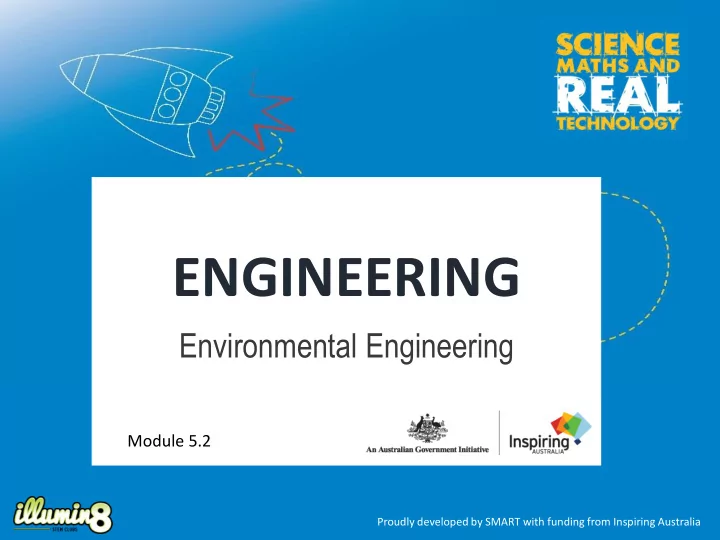

ENGINEERING Environmental Engineering Module 5.2 Proudly developed by SMART with funding from Inspiring Australia
Environmental Engineers Video: What is Environmental Engineering? http://www.mybigtomorrow.com.au/careers/details/environmental-engineer Image source: http://peopleforthefuture.com.au/professional/environment/environmental- engineer/
Oil Spills: Man Made Environmental Disasters Image sources: https://commons.wikimedia.org/wiki/File:Oiled_Bird_-_Black_Sea_Oil_Spill_111207.jpg https://seaturtles.org/newssection/endangered-gulf-sea-turtles-trouble-four-years-bp-oil-spill/
Oily Water 1 Aim : To observe oil and water interacting Materials (Facilitator demonstration): • 1 Litre clear bottle / jar • 3/4 cup Water • 2 cups cooking oil (e.g. canola) • Food colouring • 2 Alka-Seltzer tablets • Funnel Procedure: 1. Pour the water into the bottle/jar. Use the funnel as needed. 2. Pour 1 cup of oil into the bottle. Use the funnel as needed. 3. Observe – does the water or the oil float to the top? It may take a few minutes for the liquids to separate. 4. Pour the remaining oil into the bottle. Use the funnel as needed. 5. Add 10 drops of food colouring. What do you see happen? 6. Break an Alka-Seltzer tablet in half and drop half into the bottle. 7. Observe and document results. 8. Add additional pieces of Alka-Seltzer to repeat. Image source: https://sciencebob.com/blobs-in-a-bottle-2/
Oily Water 2 Aim : To observe oil and water interacting Materials (per group): • Clear plastic bottle or jar • Water (to almost fill bottle / jar) • 3 tablespoons cooking oil (e.g. canola) • Food colouring • Salt (approx. 3 teaspoons) Procedure: 1. Pour the water into the bottle until it is almost full. 2. Sprinkle in a few drops of food colouring. 3. Add 3 – 5 tablespoons of oil into the bottle. 4. Sprinkle salt onto the oil bubble, until you see oil bottles start to sink. 5. Observe and document your results. Optional: shine a torch light on the bottle as you add the salt. Extensions: • Try the experiment with two bottles, one with icy cold water and one with warm water (max 40 degrees Celsius). Is there a difference in how the oil reacts? • What happens if you use less water, and more oil? https://busybugs.co/2013/01/diy-lava-lamps.html
Booms Image sources: https://www.sciencelearn.org.nz/resources/1140-cleaning-up-the-oil-spill http://www.eoearth.org/view/article/160691/ http://www.sanol.se/eng/images/03.jpg?crc=348730298
Skimmers Image source: http://www.nauticexpo.com/prod/aqua-guard-spill-response/product-32631-255242.html http://global.lamor.com/products/skimmer-systems-small/lamor-weir-skimmers-lws-500-and-lws-800/ http://www.elastec.com/oilspill/oildrumskimmers/tds136/ http://thebigspill.providence.wikispaces.net/Oil+Spill+Containment
In In-situ Burning Image source: http://www.eoearth.org/view/article/160691/
Sorbents Image source: http://www.castagra.com/2014/05/how-to-clean-up-an-oil-spill/ http://www.hydro-carbon.nl/hydro-carbon-separation/oil-adsorption-woolspill/
Absorption Aim : To observe how materials absorb liquids Materials (per group): • • 6 cotton balls 2 x plastic bottles, jars or tubs • 30 cm Length of stocking • Aluminium BBQ tray (or shaped foil) • 2 sheets paper towel • 2 sheets newspaper • 1 cup wood shavings or straw • ½ cup oil mixture and ½ cup water • Timer • 2 sponge pieces • • 30 ml measuring cup 2 small pieces cloth (“ Chux ” or similar) Procedure: 1. Place the newspaper on the table, and the aluminium tray on the newspaper. Place your jars inside the aluminium tray to contain spills. 2. Pour 30 ml of water into one jar and 30 ml oil mixture into the other. 3. Experiment with the materials to see how well they absorb oil, and how they well absorb water. 4. Time how long different materials take to absorb the liquids. 5. Record and document your observations.
Collection: Containment: Removing the oil Stopping the oil spill from the water from spreading
Your team of environmental engineers have been called in to help with one of Australia’s worst oil spills! Two container ships carrying oil have collided off the coast of Queensland. The accident has released thousands of tonnes of oil into the protected waters of the Great Barrier Reef. Your team are our last hope to contain and clean up the spill before irreversible damage is done to the environment! Design an oil containment and collection device! This can be two separate devices, or a combined device.
The Rule les • The devices must not use any toxic chemicals - you’re working in the protected marine environment of the Great Barrier Reef! • The device should not collect excess water. Good separation of oil and water will result in a higher score! • You will have 3 minutes test time for the official test of your device. The less time your device takes to clean up the spill, the more points awarded. • The amount of oil left on the surface of the water after your test time runs out will determine the effectiveness of your device. The less oil the more points! • You can test your device during the design and build time.
Materials • • Paper Aluminium baking trays • • Paper towel Sponge • • Rubber bands Dagwood dog sticks • • Straws Cotton balls • • Tape hair rollers • • Tooth picks Paddle pop sticks • • Wood shavings or straw Pantyhose
Recommend
More recommend